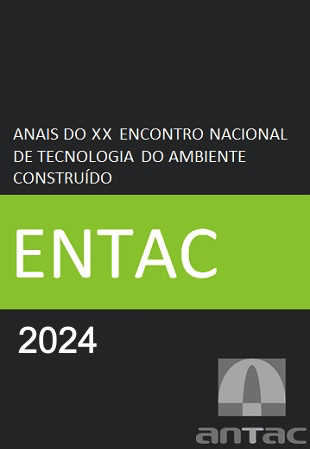GREEN BIM in undergraduate architecture and engineering education: a literature review
DOI:
https://doi.org/10.46421/entac.v20i1.6207Keywords:
Green BIM, Teaching, BIM, SustainabilityAbstract
The BIM methodology combined with sustainability is called Green BIM. This phenomenon arises to optimize resources, reduce pollution, promote sustainability and improve human health. Based on the new functions of the architect through the use of BIM in the face of the demand for buildings with sustainable solutions, it is clear that the training of future professionals needs to accompany this transformation, considering that there must be a relationship between what is taught in architecture schools and engineering and professional practice. The objective of this article is to identify, categorize and analyze scientific publications related to Green BIM with application in teaching, through the Systematic Literature Review (RSL). The study returned 73 works in total, after screening 13 works were identified focusing on Green BIM and teaching. The research was analyzed and divided between Green BIM teaching methods, experiments, case studies and literature review, proposing directions in the field of study for future research. Thus, this work intends to contribute to the structuring of knowledge and as a guide for researchers and teaching professionals in architecture and engineering.
References
BRASIL. (2020). Decreto n. 10306, de 02 de abril de 2020. Estabelece a utilização do Building Information Modelling na execução direta ou indireta de obras e serviços de engenharia realizada pelos órgãos e pelas entidades da administração pública federal. Diário Oficial da União. Brasília, DF. Disponível em: https://www.in.gov.br/en/web/dou/-/decreto-n-10.306-de-2-de-abril-de-2020-251068946.
LAMBERTS, R.; DUTRA, L.; PEREIRA, F.O.R. Eficiência energética na arquitetura. 3ªed. SãoPaulo: Editora Eletrobras/Procel, 2014.
ARROS, N. N; RUSCHEL, R. C; BIM no contexto sustentabilidade. Aplicações contemporâneas de sustentabilidade em diferentes contextos / Organizadores Tassiane Boreli Pinato... [et al.]. São Bernardo do Campo: Universidade Metodista de São Paulo, 2024. 228 p. ISBN 978-65-86452-92-1
BARISON, M. B. Introdução de Modelagem da Informação da Construção (BIM) no currículo: uma contribuição para a formação do projetista. 2015. Tese (Doutorado em Construção Civil) – Escola Politécnica da Universidade de São Paulo, Departamento de Engenharia de Construção Civil. São Paulo, 2015.
GALVÃO, T. F.; PEREIRA, M. G. Revisões sistemáticas da literatura: passos para sua elaboração. Epidemiologia e Serviços de Saúde, Brasília, DF, v. 23, p. 183-184, 2014. Disponível em:<http://scielo.iec.gov.br/scielo.php?script=sci_arttext&pid=S167949742014000100018. Acesso em: 20 fev. 2023. doi:http://dx.doi.org/10.5123/S1679-49742014000100018.
V. CARDOSO, I. TREVISAN, D. A. Cicolella, and R. Waterkemper, “Revisão sistemática de métodos mistos: método de pesquisa para a incorporação de evidências na enfermagem,” Texto & Contexto Enfermagem, vol. 28, pp. 1-12, April 2019. doi: 10.1590/1980-265X-TCE-2017-0279
KIM, J. Effectiveness of green-BIM teaching method in construction education curriculum. En 2014 ASEE Annual Conference & Exposition. 2014. p. 24.459. 1-24.459. 11.
Zakharova, G. B.; Krivonogov, A. I.; Kruglikov, S. V.; Petunin, A. A. Energy-efficient technologies in the educational programs of the architectural higher education schools. Acta Polytechnica Hungarica Vol. 17, No. 8, 2020
LEON, I., SAGARNA, M., MORA, F.; OTADUY, J. P. BIM application for sustainable teaching environment and solutions in the context of COVID-19. Sustainability, 2021, vol. 13, no 9, p. 4746. DOI: https://doi.org/10.3390/su13094746
SHEN, Z.; JENSEN, W. G.; FISCHER, B. A.; WENTZ, T. G. Using BIM to teach design and construction of sustainable buildings. En 2012 ASEE Annual Conference & Exposition. 2012. p. 25.1420. 1-25.1420. 11.
ZHANG, J; SCHMIDT, K; LI, H. BIM and sustainability education: Incorporating instructional needs into curriculum planning in CEM programs accredited by ACCE. Sustainability, 2016, vol. 8, no 6, p. 525. DOI: https://doi.org/10.3390/su8060525
LIU, Q; WANG, Z. Green BIM-based study on the green performance of university buildings in northern China. Energy, sustainability and society, 2022, vol. 12, no 1, p. 12.
BENNER, J; MCARTHUR, J. J. Data-driven design as a vehicle for BIM and sustainability education. Buildings, 2019, vol. 9, no 5, p. 103. DOI: https://doi.org/10.3390/buildings9050103
SANCHEZ-LITE, A.; ZULUETA, P.; SAMPAIO, A.Z.; GONZALEZ-GAYA, C. Bim for the realization of sustainable digital models in a university-business collaborative learning environment: Assessment of use and students’ perception. Buildings, 2022, vol. 12, no 7, p. 971. DOI: https://doi.org/10.3390/buildings12070971
SCHÜTZENHOFER, S; NIC, M; KOVACIC, I. Design optimisation via BIM supported material passports. In: Anthropologic: Architecture and Fabrication in the cognitive age–Proceedings of the 38th eCAADe Conference. 2020. p. 289-296.
SVENNEVIG, P. R; HJELSETH, E. Experiences from implementation of sustainability in a civil engineering course at the University of Agder. In: INTERNATIONAL CONFERENCE ON ENGINEERING AND PRODUCT DESIGN EDUCATION., 2017, OSLO AND AKERSHUS UNIVERSITY COLLEGE OF APPLIED SCIENCES, NORWAY.
LI, N.; JIANG, P.; LI, C.; WANG, W. College teaching innovation from the perspective of sustainable development: the construction and twelve-year practice of the 2p3e4r system. Sustainability, 2022, vol. 14, no 12, p. 7130. DOI: https://doi.org/10.3390/su14127130
MILIC, R. J; MCPHERSON, P.; MCCONCHIE, G.; REUTLINGER, T.; SINGH, S. Architectural history and sustainable architectural heritage education: Digitalisation of heritage in New Zealand. Sustainability, 2022, vol. 14, no 24, p. 16432.
SOUZA, M. A. de; BORGES, T. S. G.; RIBEIRO, R. de A.; ÁVILA, P. V. M. Leite de.; CHECCUCCI, Érica de S. Revisão sistemática de literatura: o uso de BIM no ensino de conforto. In: SIMPÓSIO BRASILEIRO DE TECNOLOGIA DA INFORMAÇÃO E COMUNICAÇÃO NA CONSTRUÇÃO, 4., 2023. Anais [...]. Porto Alegre: ANTAC, 2023. DOI:10.46421/sbtic. v4i00.2613.

